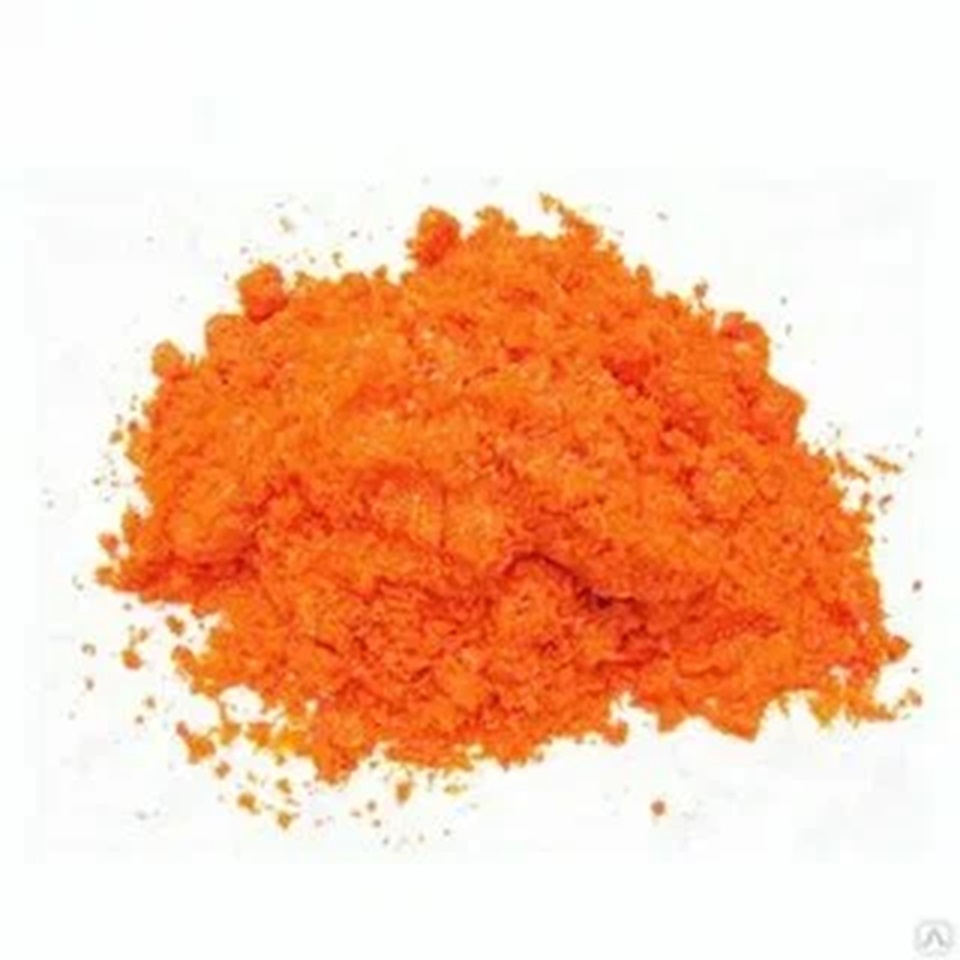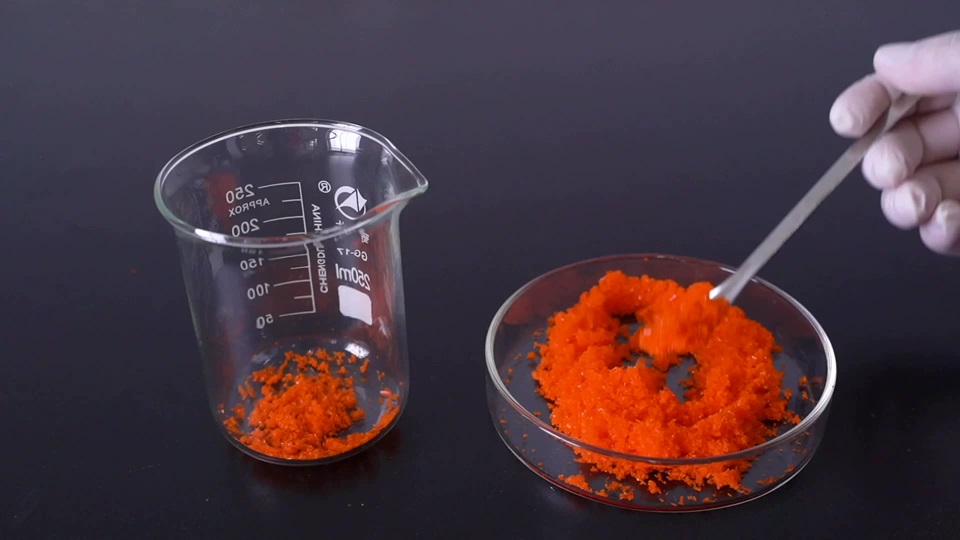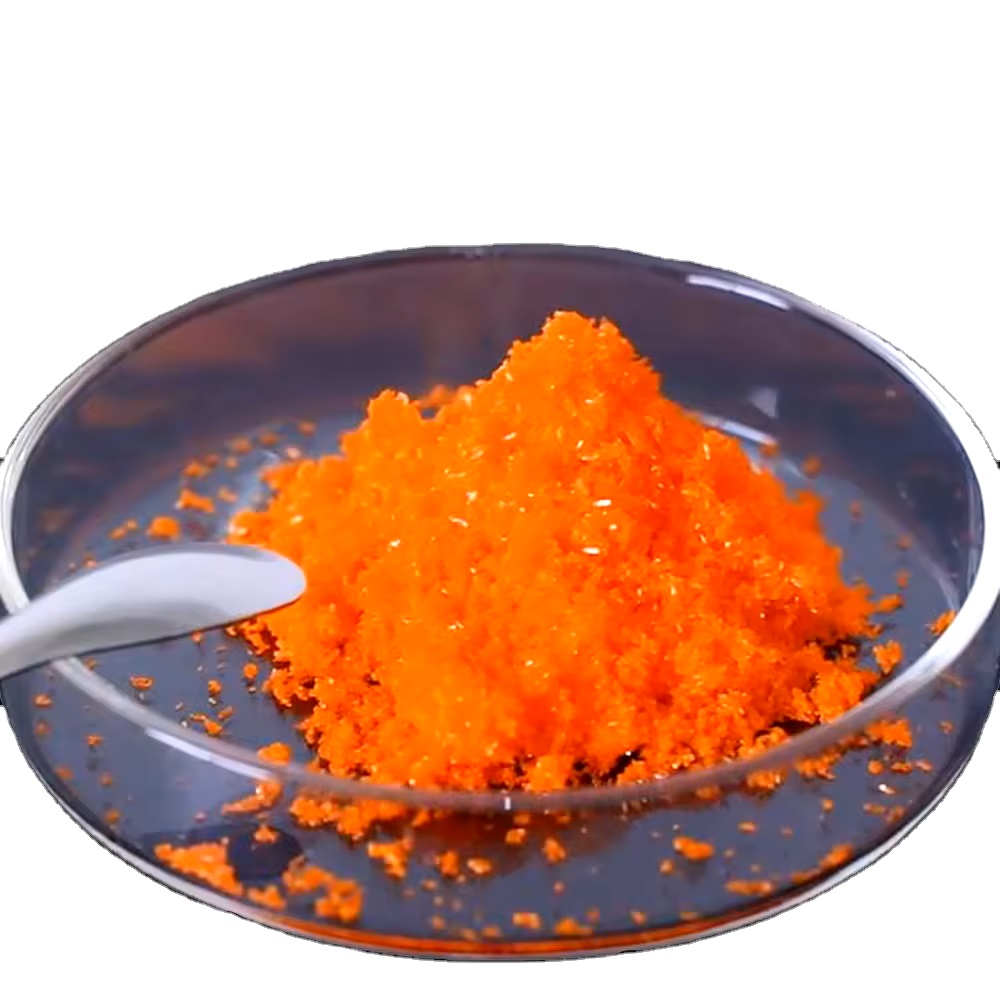We unleash your business potential by maximize the business innovation.
Send EmailSodium Dichromate, Sodium Bichromate, 10588-01-9
10588-01-9
CAS: 10588-01-9
Molecular Formula: Cr2Na2O7
Names and Identifiers
| Name | Sodium Dichromate |
| Synonyms | celcure bichromateofsoda Sodium Bichromate Sodium Dichromate bichromatedesodium celcurewoodpresrvative bichromatedesodium(french) chromicacid(h2cr207),disodiumsalt chromicacid(h2cr2o7),disodiumsalt disodium oxido-(oxido-dioxo-chromio)oxy-dioxo-chromium disodium oxido-(oxido-dioxo-chromio)oxy-dioxo-chromium dihydrate |
| CAS | 10588-01-9 |
| EINECS | 234-190-3 |
| InChI | InChI=1/2Cr.2Na.2H2O.7O/h;;;;2*1H2;;;;;;;/q;;2*+1;;;;;;;;2*-1/rCr2O7.2Na.2H2O/c3-1(4,5)9-2(6,7)8;;;;/h;;;2*1H2/q-2;2*+1; |
Physico-chemical Properties
| Molecular Formula | Cr2Na2O7 |
| Molar Mass | 261.97 |
| Density | 2.52 g/cm3(Temp: 13 °C) |
| Melting Point | 356.7°C |
| Water Solubility | 2355g/L at 20℃ |
| Vapor Presure | 0Pa at 20℃ |
| Appearance | red hygroscopic crystals |
Risk and Safety
| Risk Codes | R45 - May cause cancer R46 - May cause heritable genetic damage R60 - May impair fertility R61 - May cause harm to the unborn child R8 - Contact with combustible material may cause fire R21 - Harmful in contact with skin R25 - Toxic if swallowed R26 - Very Toxic by inhalation R34 - Causes burns R42/43 - May cause sensitization by inhalation and skin contact. R48/23 - R50/53 - Very toxic to aquatic organisms, may cause long-term adverse effects in the aquatic environment. |
| Safety Description | S53 - Avoid exposure - obtain special instructions before use. S45 - In case of accident or if you feel unwell, seek medical advice immediately (show the label whenever possible.) S60 - This material and its container must be disposed of as hazardous waste. S61 - Avoid release to the environment. Refer to special instructions / safety data sheets. |
| UN IDs | 3086 |
| Hazard Class | 6.1(a) |
| Packing Group | II |
| Toxicity | LD50 oral in rat: 50mg/kg |
Nature
orange-red monoclinic pyramidal or fine needle-like crystals. Melting point 356.7 °c (anhydrous). The relative density was 2.52. Soluble in water, its aqueous solution is acidic, insoluble in alcohol. The water of crystallization is lost when heated to 84.6 °c to form a copper-brown anhydrate. Decomposition to chromic acid at about 400 ℃
Sodium and chromium trioxide. Easy deliquescence and pulverization. It is a strong oxidant. Contact friction and impact with organic matter can cause combustion. Corrosive. Toxic!
Preparation Method
The production of sodium dichromate mainly includes two steps: the production of sodium chromate and the conversion of sodium chromate into sodium dichromate. At present, sulfuric acid method is mainly used in sodium chromate conversion industry. Electrolysis is being developed. Sulfuric acid method: the chromite ore is crushed to 200 mesh, mixed with soda ash (the general amount is 90% ~ 93% of the theoretical amount), dolomite powder, limestone powder and slag according to a certain ratio and then sent to the rotary kiln, oxidative calcination was carried out at 1100 -1150 °c 1. 5~2H. Chromium Oxide was converted to sodium chromate. After cooling and pulverizing the sintered clinker, the sintered clinker is subjected to Multistage countercurrent leaching and Suction filtration with a dilute solution and water in an extractor to obtain a sodium chromate solution of 35 to 400be. The pH was adjusted to 7-8, and the sodium aluminate was hydrolyzed to aluminum hydroxide precipitate, which was filtered and then removed. After evaporation of the neutral filtrate to 480be, the sodium chromate was converted to sodium dichromate by acidification with concentrated sulfuric acid. After two evaporations, the sodium sulfate was completely removed and clarified to remove all insoluble impurities. The clear solution was cooled to 30-40 ° C. For crystallization, and centrifuged to prepare a sodium dichromate product. The mother liquor is returned for neutralization or for use in the manufacture of other chromium salt products.
Use
It is used for the production of chromic anhydride, potassium dichromate, basic chromium sulfate, chrome yellow, lignin sulfonate and the like. The leather industry is used as a tanning agent. In the printing and dyeing industry, it is used as an oxidant when dyeing aniline dyes, as a post-treatment agent when dyeing sulfide vat dyes, and as a mordant when dyeing acid mordant dyes. The pharmaceutical industry is used for the production of amine phenyl sulfone, benzocaine, folic acid, raffonor and so on. The electroplating industry is used for passivation treatment after zinc plating to increase the brightness. It is also used for metal surface treatment. For the production of alkaline blue dye, saccharin, synthetic camphor, synthetic fiber, synthetic spices.
Safety
is a toxic product containing hexavalent chromium. Long-term inhalation can damage the nasal mucosa, causing nasal inflammation and septal cartilage perforation, so that respiratory organs are damaged. When the skin contact with sodium dichromate solution and powder, it is easy to cause chromium sores and dermatitis. When the broken skin is in contact with it, it will cause ulcers that are not easy to heal. When the eye is contaminated, it can cause conjunctivitis and even blindness. Therefore, if there is sodium dichromate solution or powder splash on the skin, should be immediately washed with a large amount of water, such as accidentally splash into the eyes, should immediately rinse with a large amount of water for more than 15min, cod Liver Oil and 30% sulfanilamide acetyl solution were added dropwise. Eating chromium salt can cause acute chromium poisoning, Abdominal Pain, Vomit, hematochezia, severe hematuria, convulsions, mental disorders and so on. Gastric lavage and detoxification with sodium sulfite solution should be performed immediately. Oral 1% magnesium oxide dilute solution, drink milk and egg white. Chromate, dichromate (Cr03) maximum allowable concentration of 0.01 mg/m3. When the concentration of sodium dichromate in air exceeds this concentration, inhalation will cause nasal mucosa ulceration. Prior to work, you must wear work clothes, rubber aprons, latex gloves, and use personal protective masks. When working, the production equipment is required to be sealed and well ventilated to prevent gas emission and dust emission. To comply with the rules of personal hygiene, after work, be sure to take a shower, the skin has a broken wound, should be coated with protective ointment. Regular physical examination should be performed every two years. Three waste treatment in Japan with chromium slag plus reducing agent and additives mixed molding, roasting reduction of artificial aggregate; Also the chromium slag with sulfite paper wastewater in the rotary kiln after reduction roasting for filling or stacking. In Romania, all of the chromium residue was stacked in the slag field of the anti-seepage measures. The treatment methods of chromium slag in China are: ① wet detoxification of chromium slag; ② dry detoxification of chromium slag; ③ calcium magnesium phosphate fertilizer made from chromium slag; ④ glass colorant made from chromium slag; ⑤ cast stone made from chromium slag, etc. Domestic chromium-containing wastewater treatment methods are: ① ferrous sulfate method I ② ion exchange method; ③ activated carbon method. Packaging and storage: sealed with an iron drum lined with a plastic bag, each net weight of 50kg, 100kg or 250kg. Package should be strong, clear "oxidant" and "with drugs" signs. It is a secondary inorganic oxidant. Risk code: GB 5.1 class 51520. Should be stored in a cool, ventilated, dry warehouse. Containers must be sealed and protected from moisture. Should be away from the heat source and fire, shall not be mixed with organic matter, flammable substances, peroxides, acid storage. During transportation, cover shall be provided to prevent rain and sun exposure. During loading and unloading, care should be taken to prevent the collision of the iron drum. Fire, water, sand, carbon dioxide fire extinguishing.
Reference Information
| LogP | -1 at 20℃ |
| application | used as raw materials for producing chromic anhydride, potassium dichromate, ammonium dichromate, basic chromium sulfate, lead chromium yellow, copper chromium red, dissolved chromium yellow, chromium oxide green, etc., to produce basic lake blue dye, saccharin, synthetic camphor and synthetic fiber oxidant. The pharmaceutical industry is used as an oxidant for the production of amine phenyl sulfone, benzocaine, folic acid, and Rifonol. The printing and dyeing industry is used as an oxidant for aniline dye dyeing, a post-treatment agent for sulfide vat dye dyeing, and a mordant for acid mordant dyeing. The tanning industry is used as a tanning agent. The electroplating industry is used for post-galvanizing passivation treatment to increase brightness. The glass industry is used as a green colorant. |
| production method | 1. chromite is crushed to 200 mesh, mixed with soda ash (the general dosage is 90% ~ 93% of the theoretical amount), dolomite powder, limestone powder and slag according to a certain ratio, then sent to a rotary kiln, and oxidized and roasted at 1100~1150 ℃ for 1.5~2h to convert chromium trioxide into sodium chromate. After the sintered clinker is cooled and crushed, a dilute solution and water are used for multi-stage countercurrent leaching and suction filtration in a leach to obtain a sodium chromate solution of 35~40 ° Bé. The pH value is adjusted to 7-8 to hydrolyze sodium aluminate into aluminum hydroxide precipitate, which is removed after filtration. After the neutral filtrate evaporates to 48 ° Bé, it is acidified by adding concentrated sulfuric acid to convert sodium chromate into sodium dichromate. After two evaporations, the sodium sulfate is completely removed, and then clarified to remove all insoluble impurities. The clarified liquid is cooled to 30~40 ℃ for crystallization, and the finished product of sodium dichromate is prepared by centrifugal separation. Mother liquor is returned to neutralization or used to make other chromium salt products. The reaction formula is as follows: |
| category | oxidant |
| toxicity classification | highly toxic |
| acute toxicity | oral-rat LD50: 50 mg/kg |
| Explosive hazard characteristics | Mixed with reducing agent, sulfur, phosphorus, etc., can be exploded by heating, impact, friction |
| flammability hazard characteristics | combustion produces toxic chromate and sodium oxide fumes |
| storage and transportation characteristics | warehouse ventilation and low temperature drying; Light loading and light unloading; Store separately from organic matter, reducing agent, sulfur and phosphorus flammable materials and food raw materials |
| fire extinguishing agent | mist water, sand |
| occupational standard | TWA 0.05 mg (chromium)/m3 |

.jpg)

